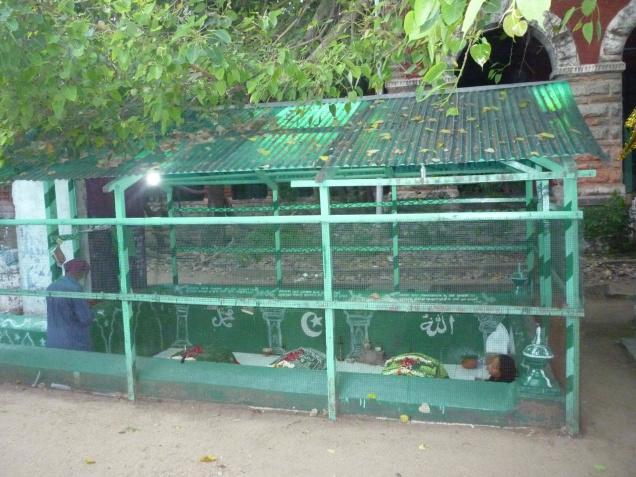The graves belonged to members of the erstwhile ruling family of Arcot. Photo: Special Arrangement / The Hindu
The graves belonged to members of the erstwhile ruling family of Arcot
I was invited to visit Presidency College last week. It is a campus I had always intended exploring, it being the first major work of Robert Fellowes Chisholm in Madras city. Wandering about the place was a fascinating experience but what intrigued me was the presence of three Mohammedan graves on the southern side, almost in the shadow of the main building.
It being evening, there was not a soul to explain the significance of the tombs. Scrawled in chalk on the wall of the enclosure were the names of the three people buried within – Hazrath Syed Zahoor Ali Shah Qaderi, Hazrath Syed Zainab Beebi Saheba Qaderi and Hazrath Syed Shahbuddin Ali Shah Qaderi. All three are in good condition, painted repeatedly and with a roof of recent origins, protecting them from the elements.
Just as I was leaving, there turned up a Muslim gentleman who began making preparations for prayer. He informed me that the three graves belonged to members of the erstwhile ruling family of Arcot and that they had been buried here around 200 years ago. When construction of the Presidency College began, care was taken to leave the graves undisturbed. The trio enjoy saintly status and an Urs festival is conducted each year in their memory during the Islamic month of Rajab.
Who they are is a mystery. But what I did glean from S. Anwar, photographer and heritage enthusiast who researches the Islamic history of this region, was that this was once the garden of Sultan-un-nissa Begum, daughter of Nawab Mohammad Ali Walajah, who in the 1760s, built the magnificent Chepauk Palace.
Sultan-un-nissa was a strong-willed person. Her father’s death in 1795 saw her brother Umdat-ul-Umrah being installed as Nawab. He managed to resist the takeover of his kingdom by the British, and in this he was probably aided by his sister. On his death in 1801, the English forcibly occupied Chepauk and tried to get Umdat-ul-Umrah’s son to hand over the kingdom, citing the infamous Arcot debts as the reason. When Umdat-ul-Umrah proved a chip off the old block, his cousin, the willing Azeem-ud-Dowlah was installed on the throne. He signed away the kingdom, retaining Chepauk Palace and its gardens alone.
He was strongly castigated for this by Sultan-un-nissa and her son Rais-ul-Omrah Bahadur (after whom a street, now sadly truncated to ROB Street still survives off Mount Road). To which he replied that he may have lost the kingdom but he had at least saved Chepauk Palace without which they would have had no roof over their heads. The response to this was sharp – would it not have been better to lose a home to save a kingdom? Sultan-un-nissa finally settled in Basrah.
Given her resistance, her property must have been among the first to be confiscated. A part was allotted for the Presidency College in the 1860s, and the rest is history.
source: http://www.TheHindu.com / Home> News> Cities> Chennai / October 09th, 2012 / by Sriram V / October 09th, 2012
